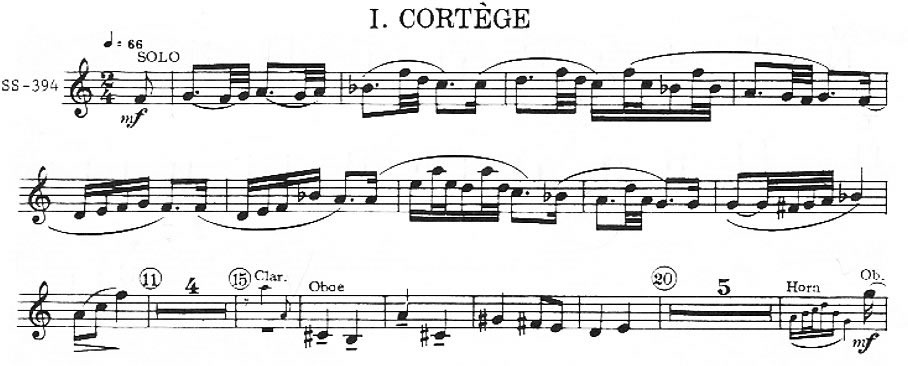<Music: Performance by Quintigre from the sixth movement.>
Hello, my name is Fatma Daglar. I teach oboe here at Towson University. I also play with Annapolis Symphony Orchestra, Maryland Symphony Orchestra, Baltimore Chamber Orchestra, and other groups in the area.
I want to talk to you today about the opening ten bars, the first ten bars, of Darius Milhaud's La cheminée du Roi Réne, the Chimney of King René. There is a lot to talk about in these opening ten bars. So let me go ahead and play for you before I go on and mention a few things.

<Demonstration of the opening ten measures on oboe>
This movement is titled Cortège. It is a processional, a regal processional. I will talk a little bit about style later on. Perhaps the first thing to talk about is to breathe in time and to establish the tempo. This will aid bringing in the ensemble together.
So, if we had a conductor, we would probably be seeing: 1, 2, <singing>. So in this case the oboe player in the quintet has to assume the role of the conductor and show with the instrument the first beat of the previous bar and breathe on the second beat before the actual pickup note. It would look like this:
<Demonstration>
Let me do that one more time.
<Demonstration>
So taking that breath in the beginning, that last and exact eighth, will make all of this very clear. So I would really practice not only your part, but also the preparation beats and how to demonstrate.
<Quintigre, performance of the opening>
Now that we have the pick up note and the downbeat, we need to make sure the dotted eighth notes do not rush. I would recommend thinking within those dotted eighth notes the actual three 16ths. Perhaps even practicing a few times those three 16ths.

<Demonstration with tongued subdivisions>
And let's go ahead and play as written.
<Demonstration>
I am really thinking about the subdivisions within the dotted eighth throughout this movement.
Now, it is very easy to play this phrase with an equally strong pulse on each quarter. Here is what I mean, it could very easily sound like this. This is something we want to avoid.
<Demonstration with pulsing>
It would be so much better to avoid this by giving a shape to the phrase. One way of discovering the natural direction that the phrase should take is to strip the music of the ornamental notes and play the basic notes. Here is what I mean.

<Demonstration with main notes only>
Now it's very clear that there is a rising movement until the downbeat of the third measure, after which we have a falling figure. Let me play once more.
<Demonstration with main notes only>
When we insert the quick notes, let's keep the same direction going through, and highlight the rising and falling contours of the phrase.
<Demonstration as written>
Finally for this opening, we want to consider setting the right character and playing in the right style. This opening movement is depicting a regal processional, as it is titled Cortège, so it needs to sound stately and weighty and never rushed. The bassoon and horn accompaniment to the melody provides that slow processional tempo and supports this oboe line in a way that evokes the sound of a medieval wind band.
It's always important to know the context of the music, and the historical period it belongs to. This is a piece written by a French composer in the 20th century, but the music hearkens back to the 15th century court of King René the first. With all this in mind, let's hear the opening 10 measures with everybody now.
<Quintigre, performing the opening>
Later on in the movement, there are some technical challenges for the oboe player. If you look at measures 42-48 there is a passage that is fairly low, in the low register and it is soft. This is then followed by a subito fortissimo.


<Demonstration>
So in order to be able to play louder immediately, after having played softer in the low register, we need to think of suddenly increasing air speed and opening up around the reed to let the air travel more freely, and for a bigger volume of air to go through the instrument. That way we can produce a bigger sound right at the downbeat of measure 49 with the subito fortissimo. So we are looking for an abrupt change not only in volume but also we can think about conveying the different phrases with a variety of articulation.
Here is the music with all of us playing from measures 42-52.
<Quintigre performing>
One other challenge here is to go from blending with the clarinet on staccatos in the low register for a bar and a half and quickly switching to playing legato, in unison with the flute in the high register for the next bar a half! The same pattern is repeated in the following three measures. Here is the oboe part alone.

<Demonstration>
Thank you for watching, and happy reed making and happy practicing!
<Music: Performance by Quintigre from the sixth movement.>
